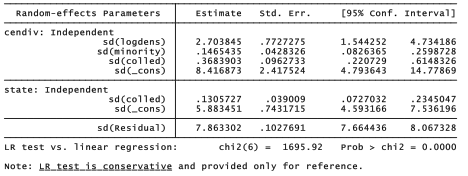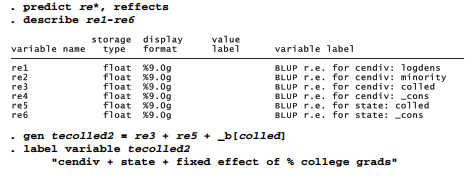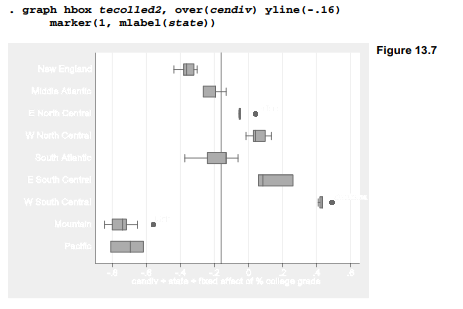Mixed-effects models can include more than one nested level. The counties of our voting data, for example, are nested not only within census divisions, but also within states that are nested within census divisions. Might there exist random effects not only at the level of census divisions, but also at the smaller level of states? The xtmixed command allows for such hierarchical models. Additional random-effects parts are added to the command, with successively smaller (nested) units to the right. The following analysis specifies random intercepts and slopes on all three predictors for each census division, and also random intercepts and slopes on percent college graduates, colled, for each state.


At first glance, all of the random effects at both cendiv and state level in this output appear significant, judging from their standard errors and confidence intervals. The standard deviation of state-level random coefficients on colled (.13) is smaller than the standard deviation of corresponding census division-level coefficients (.37), but both are substantial relative to the fixed-effect coefficient on colled (-.18). Our confidence interval for the state-level coefficient ranges from .07 to .23. A likelihood-ratio test indicates that this model (here named state) with state-level random intercepts and slopes fits much better than our earlier model (full), which had only census division-level random intercepts and slopes.

As before, we can predict the random effects, then use these to calculate and graph the total effects. For colled, we now have random effects for 49 different states. Box plots work well to show their distribution (Figure 13.7), which follows the general pattern of census division effects seen earlier in Figure 13.6, but now also within-division variation. Indiana (E North Central) and Oklahoma (W South Central) plot as outliers, because each is unusual within its division.


For other xtmixed postestimation tools, type help xtmixed postestimation. The Longitudinal/ Panel Data Reference Manual, and also Rabe-Hesketh and Skrondal (2012), present further applications of mixed modeling such as blocked-diagonal covariance structures and crossed- effects models.
Source: Hamilton Lawrence C. (2012), Statistics with STATA: Version 12, Cengage Learning; 8th edition.

I got what you intend,saved to favorites, very nice site.